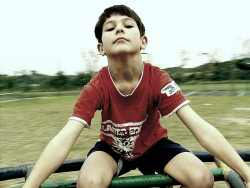Child with sore arm = Child with Migraine ?
“Oh, she’s just trying to get out of going to school again.” So in spite of the supposed pain, Emma is rushed to the car and off to school she goes.
But is she really trying to avoid school? Or is the pain a sign of something more physical – like migraine?
 We don’t usually associate sore body parts with migraine, but we should. Migraine patients know that the pain can affect the whole body.
We don’t usually associate sore body parts with migraine, but we should. Migraine patients know that the pain can affect the whole body.
But for some people, particularly children, there may be pain in some location – such as the stomach, an arm, or a shoulder, for example – but no headache at all, or perhaps no headache at the same time.
Abdominal migraine – most common in children, but also happening in adulthood – is well known. There may be no headache at all, but possible stomach pain, no appetite, nausea, and pallor (going pale).
But what about other parts of the body? A family case has been reported – probably a genetic trait – where a child would have recurring pain in childhood which seemed to become more typical migraine in adulthood.
We’re not just talking about any pain, of course. Most children are going to have some kind of pain, often unexplained pain.
But a study from this past September (Familial Migraine Limb Pain Syndrome (MLPS): Three Generations and Seven Year Follow-up) has shed a little more light on this type of migraine pain.
This time, the pattern could be seen in a family over three generations. The syndrome is known as migraine-limb pain syndrome (MLPS), which actually could refer to pain related to migraine or cluster.
 In these cases, the intensity of the pain varied. Although the pain seemed to follow a migraine pattern (temporary, often accompanied by other symptoms), it did not always occur at the same time as other symptoms.
In these cases, the intensity of the pain varied. Although the pain seemed to follow a migraine pattern (temporary, often accompanied by other symptoms), it did not always occur at the same time as other symptoms.
Here are some of the observations in the study:
- Pain began as early as age 8, or as late as age 30.
- It lasted between 5 and 52 years.
- Pain was one-sided, although the side may change in the next attack.
- Headache could appear before, during, or after body pain.
- In adults, some attacks included body pain, but no headache.
- Most patients experienced some kind of aura at some time. Elderly people had more aura and less severe headache.
- Common pain sites were an arm, shoulder, chest, and neck.
- The syndrome could be inherited from only one parent.
Even during attacks of body pain, patients acted like they were having a migraine attack – that is, they wanted to withdraw, and were often pale.
The researchers note that leg pain is also a manifestation of MLPS.
Obviously, studying one family is not a massive study. However, this study is more important than it looks.
Why? Well, we already know that pain in other parts of the body is a common issue in migraine. We also know that many people don’t report – or even think about – pain in their hand or leg when they’re also dealing with migraine nausea and severe migraine headache pain.
So this issue is probably a lot bigger than we realize. And if doctors and patients were more aware, they might be able to catch migraine earlier, and find better treatment. Also, as the researchers note, they could avoid common misdiagnoses (such as pressure on a nerve, myalgic encephalopathy/chronic fatigue, and arthritis).
The good news is that typical migraine treatments seem to successfully treat MLPS.
What kind of body pain have you experienced in connection with your migraine attacks? How long did it take for you to find a proper diagnosis?
Read more at Medscape: Limb Pain May Be Unrecognized Manifestation of Migraine

